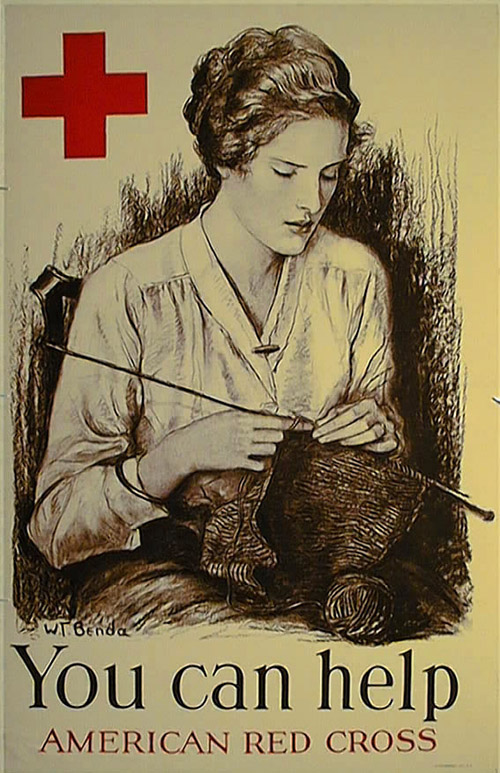
|
|
| The poster shows an American woman dressed in clothing typical of middle-
to upper-class women of the time. This is a strong, domestic image
that shows the woman sitting alone on a chair in a room separated from
any other objects or individuals. She seems to be very obedient,
knitting with her head lowered and eyes partly closed - a typical motherly
chore. Women were becoming valued for their work; however, they were
still expected to stay at home and perform domestic duties. Women,
such as the one in this poster, were protected and thought of as precious,
which kept them from being directly involved in the fighting overseas.
The main theme in this poster is the importance of women's support during the United States' involvement in WWI. The image, based on a drawing by W.T. Benda, shows that women's involvement in the war was highly valued, even if they were not fighting on the battle lines. (1) This idea is represented in the work's upper left-hand corner where a bold red cross represents the American Red Cross' involvement. The Red Cross was created in the U.S. in 1904, becoming the official disaster relief arm of the U.S. government. As soon as the war began in Europe, the American Red Cross started collecting supplies and enrolling medical personnel. (2) The Red Cross employed women and volunteers who provided services to people and soldiers in need. The organization was a great financial success, bringing in pledges of more than $115 million. (3) By the time America entered the Great War, the Red Cross had already enrolled more than eight thousand nurses and had created hospital units in big cities. The duties of the Red Cross workers often involved giving blood and making blankets. By October 1, 1918, U.S. women had made, packed, and shipped 253 million surgical dressings. They had also turned 2.5 million pounds of wool into socks and sweaters and had made 275 million articles of clothing for European relief. (4) The figure's skin is white and pure and presents an image of ideal beauty. Her hair is neatly pulled back into a bun and her clothing is neatly maintained, symbolic of middle- to upper-class women of the time. Her overall appearance of innocence undoubtedly appealed to males and females alike. To males, she probably represented the ideal wife. To women, she represented everything they strived to become: beautiful, well-dressed, and appreciated for their work in the war effort. This poster is an ideal image of a time in American history when women were viewed as fragile and motherly, yet they were beginning to earn widespread appreciation from society through their efforts in the war. 1. Walton Rawls, Wake Up America! (New York: Abbeville
Press, 1988), 128.
|